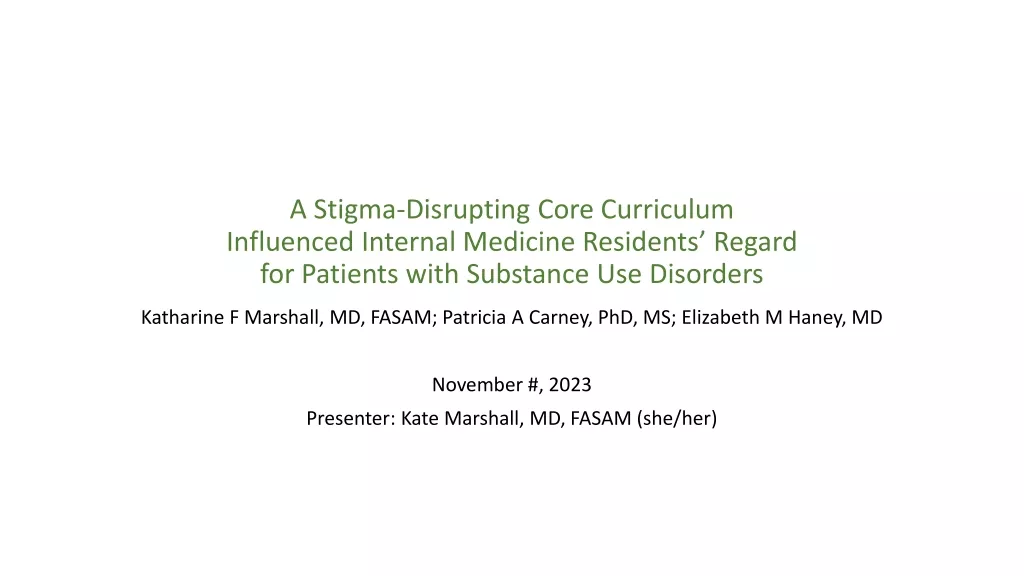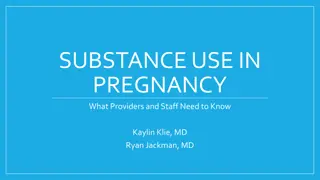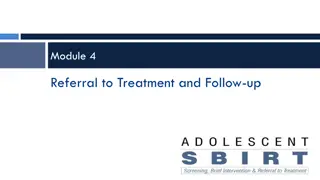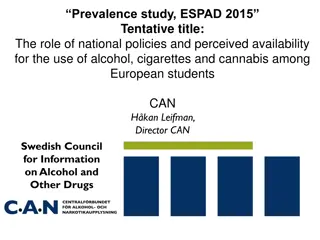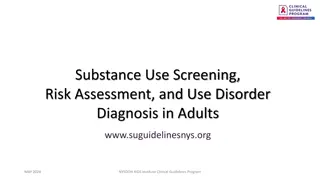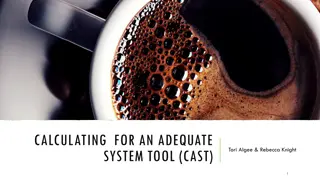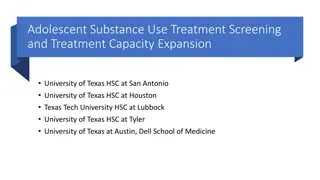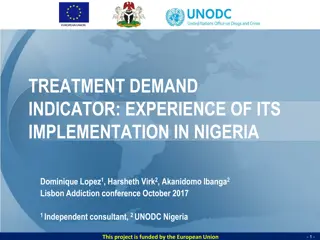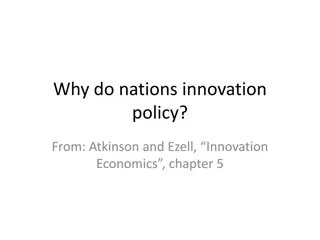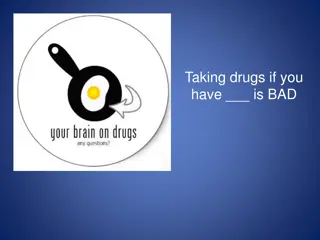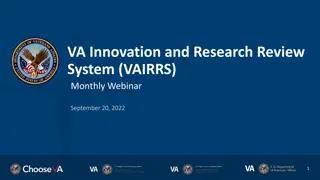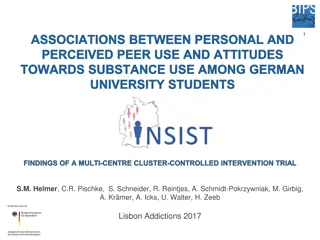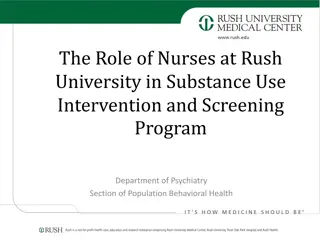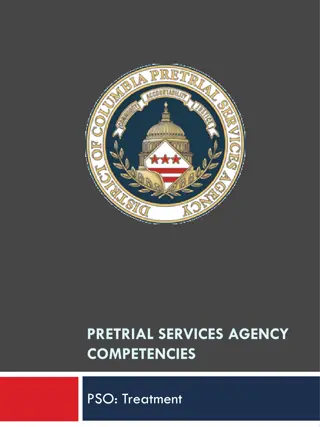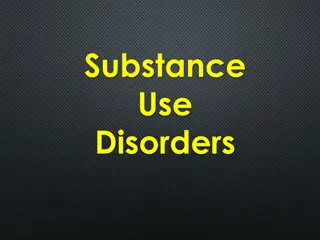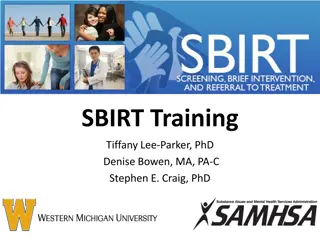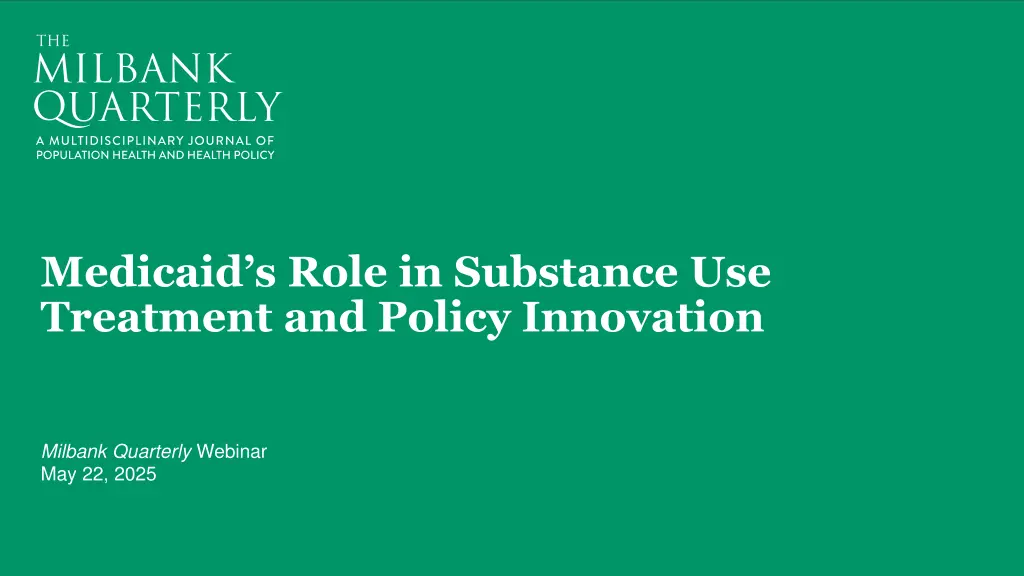
Medicaid's Role in Mental Health & Substance Use Treatment
Discover the pivotal role of Medicaid in addressing mental health and substance use disorders. Learn about policy innovations, insights from industry experts, and the impact on millions of Medicaid beneficiaries. Join the discussion on challenges and progress in this critical healthcare area.
Download Presentation

Please find below an Image/Link to download the presentation.
The content on the website is provided AS IS for your information and personal use only. It may not be sold, licensed, or shared on other websites without obtaining consent from the author. If you encounter any issues during the download, it is possible that the publisher has removed the file from their server.
You are allowed to download the files provided on this website for personal or commercial use, subject to the condition that they are used lawfully. All files are the property of their respective owners.
The content on the website is provided AS IS for your information and personal use only. It may not be sold, licensed, or shared on other websites without obtaining consent from the author.
E N D
Presentation Transcript
Medicaids Role in Substance Use Treatment and Policy Innovation Milbank Quarterly Webinar May 22, 2025
Panelists Hannah Maniates, Senior Policy Analyst, National Association of Medicaid Directors Brendan Saloner, Bloomberg Professor of American Health, Johns Hopkins Bloomberg School of Public Health Kelly Crosbie, Director of the Division of Mental Health, Developmental Disabilities, and Substance Use Services, North Carolina Department of Health and Human Services (discussant) Beth McGinty, Livingston Farrand Professor, Weill Cornell Medical College(moderator) WWW.MILBANK.ORG
Medicaids Role in Addressing the Mental Modern Annual Report Health and Substance Use Disorder Challenges of Its Members Milbank Quarterly May 22, 2025 ______ 2020
National Association of Medicaid Directors NAMD is a professional community of state leaders who provide health insurance to almost 80 million people through Medicaid and CHIP in the 50 states, D.C. and the U.S. territories. NAMD elevatesthought leadership on policy matters, amplifies the experience and expertise of state leaders, supports programs in continuous improvement and innovation, and optimizes partnerships to help millions live their healthiest lives. 56 Medicaid programs NAMD is led by a mission-focused 14-person Board of Directors whose members represent the states of Alabama, Arkansas, Kentucky, Maine, Maryland, Nevada, New Hampshire, North Dakota, Oregon, Virginia, Wisconsin, Wyoming, the District of Columbia and the U.S. Virgin Islands. www.medicaiddirectors.org
56 Medicaid programs www.medicaiddirectors.org
Our central question Why is the Medicaid program both a standard- bearer and a work-in-progress in addressing MH/SUD conditions? www.medicaiddirectors.org
What well cover What is Medicaid s role in addressing mental health (MH) and substance use disorder (SUD)? How and why do we see variation in coverage of MH/SUD services in Medicaid? How and why do we see Medicaid driving innovations in care? www.medicaiddirectors.org
Medicaids role in addressing MH/SUD As of December 2024, 78.5 million people enrolled in Medicaid or CHIP (CMS 2025) In 2020, 39% of Medicaid members had a MH or SUD condition (KFF 2020) Medicaid is a critical access point to MH/SUD care for its members As of 2018, 44.2% of adult Medicaid members with past-year mental illness received treatment (MACPAC 2021) As of 2020, 74% of Medicaid members with a diagnosed SUD received some type of treatment or supportive service (KFF 2024) www.medicaiddirectors.org
Variation in coverage There is substantial variation across states in coverage of MH/SUD services States/territories must cover certain mandatory benefit categories and can electively cover a range of optional services through state plan and waiver authorities All states cover MH screenings and assessments, some type of outpatient MH treatment, and psychiatric care; lower rates of coverage for residential services, supportive services, and skills training (MACPAC 2021) Higher rates of coverage for early intervention and outpatient SUD services and lower rates of coverage for partial hospitalization and residential SUD services (MACPAC 2018) States are focused on filling gaps in care by covering additional benefits, increasing reimbursement rates, and building the MH/SUD workforce (KFF 2024) www.medicaiddirectors.org
Drivers of variation in coverage LACK OF DEFINED, UNIFORM FEDERAL BENEFIT DIFFERING STATE PRIORITIES DIFFERING STATE CONSTRAINTS www.medicaiddirectors.org
Our central question Why is the Medicaid program both a standard- bearer and a work-in-progress in addressing MH/SUD conditions? www.medicaiddirectors.org
Innovations in MH/SUD care CHILDREN WITH COMPLEX BEHAVIORAL HEALTH NEEDS REENTRY FROM INCARCERATION SUPPORTIVE HOUSING www.medicaiddirectors.org
Children with complex BH needs Managed care model for children and youth with significant BH needs Provides comprehensive care, including intensive care coordination, crisis response and stabilization, intensive in-home services, and residential care in addition to state plan services, with goal of reducing unnecessary placements in residential treatment Braids federal authorities including state plan authorities, 1915(b)(e) waiver to provide respite and flex funds , and 1915(c) waiver to provide highest-intensity services Shared governance model, including Ohio Medicaid, Governor s Office, and Cabinet Council of nine state agencies www.medicaiddirectors.org
Reentry from incarceration Source: KFF Medicaid Waiver Tracker www.medicaiddirectors.org
Supportive housing 50% of households with at least one Medicaid or CHIP member reported having at least one housing problem (CMS 2023) Access to permanent supportive housing may reduce Medicaid spending, emergency department use, and inpatient hospital stays (Hollander et al., 2021) State initiatives: Louisiana: Permanent supportive housing model that provides eligible individuals who have disabilities including MH/SUD with tailored services including pre-tenancy supports, tenancy-sustaining services, social supports, crisis intervention, etc. Connecticut: Money Follows the Person housing plus services model that uses 1915(i) state plan authority to provide transition and tenancy-sustaining supports in conjunction with housing vouchers for people with MH/SUD and other serious health conditions www.medicaiddirectors.org
Drivers of innovation FISCAL INCENTIVES Longer period of engagement than private plans; states bear cost of multi-system outcomes FEDERAL AUTHORITIES Permissive set of federal authorities and periodic federal demonstration funds STATE GOV. STRUCTURE State policymakers have direct control over agencies that administer Medicaid and social services POLITICAL INCENTIVES Voters consistently rank MH/SUD as top priority www.medicaiddirectors.org
Conclusion Medicaid is a critical source of coverage for MH/SUD services The state/federal structure of the Medicaid program has led to both substantial variation in coverage of MH/SUD services across states/territories and innovations in care Medicaid may be uniquely well-positioned to drive cross-system innovations, including partnerships with child and family agencies, corrections, and housing agencies Key areas of continued work include addressing gaps in care, initiatives to address workforce challenges, and the need to grow the evidence base for Medicaid interventions www.medicaiddirectors.org
Thank you! Kate McEvoy Executive Director Hannah Maniates Senior Policy Analyst Hannah.Maniates@medicaiddirectors.org Kate.McEvoy@medicaiddirectors.org www.medicaiddirectors.org
The Long Arc of Substance Use Policy Innovation in Medicaid: Looking Back, Looking Forward Brendan Saloner Read the paper Johns Hopkins Bloomberg School of Public Health Milbank Quarterly Special Issue Briefing May 22, 2025
The innovation problem in SUD services Innovation: novel set of behaviors, routines, and ways of working that are directed at improving health outcomes, administrative efficiency, cost effectiveness, or users experience. (Greenhalgh et al. 2004) Innovations in SUD treatment do not typically come from new technologies, but from new approaches to organizing, delivering, and financing services Medicaid drives much of the SUD treatment innovation, because of its outsized role as a payer (covers 11% of adults, but 20% of SUD treatment spend) Last 20 years have been marked by expanded coverage and services mandates: MHPAEA (2008) ACA (2010) SUPPORT Act (2018)
How do Medicaid policymakers innovate around SUD services? Inputs (Resources) The production function (innovation) Outputs (Results) Federal Medicaid rules Utilization of SUD treatment State Medicaid policy (state plan coverage, waivers, eligibility, contracts with providers) Retention Abstinence Recovery Managed care, managed behavioral health care Social functioning
How do Medicaid policymakers innovate around SUD services? Inputs (Resources) The production function (innovation) Outputs (Results) Federal Medicaid rules Utilization of SUD treatment Delivery system reform State Medicaid policy (state plan coverage, waivers, eligibility, contracts with providers) Retention Value-based payment Abstinence Recovery Integration with other systems and services Managed care, managed behavioral health care Social functioning
Delivery System Reform Build the capacity of the delivery system through more requirements, reimbursement, and demonstrations Strategies: Minimum standards of care (e.g., requiring residential MOUD coverage) Coverage of new services (e.g., low threshold) Greater flexibility in delivery (e.g., take-home bundled payments)
Value-Based Payment Create measurable outcomes and pay providers, managed care plans, (and patients) to meet targets Strategies: Reportable quality metrics (e.g., SUD-related measures in the Core Set ) Payments for meeting metrics (e.g., quality bonuses paid to MCOs) Contingency management (paying patients to meet recovery goals)
Integration with Social and Criminal Legal Systems Allow Medicaid beneficiaries to receive services to address case management or coordination across multiple non-health service systems Strategies: Housing-related assistance (e.g., supporting placements in housing first ) Supported employment (e.g., programs with zero exclusions philosophy) Jail/prison reentry (e.g., 1115 Reentry Waivers)
The Long Arc of Medicaid SUD Policy Bends toward Innovation Most consequential two decades of US SUD policy have raised the floor on minimum services, created new systems of billing, and promoted more mainstreaming of care Tons of interesting innovations, though few have been well evaluated Hard to separate the beneficial changes in programs and services from the negative impacts of the continuing drug overdose crisis We are in a period of unprecedented uncertainty under the second Trump Administration Best case scenario is to identify program efficiencies and cost offsets (where they exist), but important to be realistic that innovations cost money upfront and many bets do not pay off
Thank you! Brendan Saloner: bsaloner@jhu.edu Saloner, B. (2025). The Long Arc of Substance Use Policy Innovation in Medicaid: Looking Back, Looking Forward. The Milbank Quarterly.
Moderated Discussion and Q&A WWW.MILBANK.ORG
Thank you for listening WWW.MILBANK.ORG


